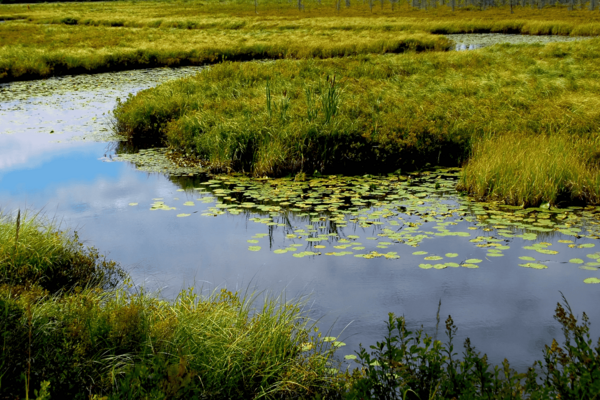
Which species will survive the global change challenge?
Waterloo researcher examines how some plant species are adjusting to change and others are losing out

Waterloo researcher examines how some plant species are adjusting to change and others are losing out
By Katie McQuaid Faculty of Science In a temperate montane forest in southern Québec, all is quiet. But if you dig a little deeper, you’ll see the landscape has a story to tell. Waterloo plant ecologist Dr. Julie Messier, alongside her collaborators from Sherbrooke, is uncovering vital insights into the changes affecting our forests — knowledge that could be crucial in safeguarding Canada’s temperate forests.
In a temperate montane forest in southern Québec, all is quiet. But if you dig a little deeper, you’ll see the landscape has a story to tell. Waterloo plant ecologist Dr. Julie Messier, alongside her collaborators from Sherbrooke, is uncovering vital insights into the changes affecting our forests — knowledge that could be crucial in safeguarding Canada’s temperate forests.
Her study derives from previous research in 1970 and 2012 that showed some species were thriving after 40 years of global change, while others were declining, and it wasn’t clear why. “Many factors can change how favourable an environment is, and a lot of them are based on climate change and air pollutants,” Messier said. “This community experienced 1.5 C of warming since the first study and significant atmospheric nitrogen deposition, both are big changes to adjust to. In response, some species became more abundant overall, whereas others saw a decline.”
Messier and her team built on this data to answer two questions: first, how did the traits of the forest community change? Second, what traits could predict the shifts in species elevation and abundance over this period? “We wanted to test the hypothesis that some species had specific traits allowing them to do well, which we hoped would enable us to predict future changes better,” she said.
To do this, Messier and her collaborators studied the plants covering the ground in the understory layer, which is the most diverse layer within a temperate forest. For 46 understory vascular species, they measured six above-ground traits and for 36 of those, they measured five below-ground traits. The data showed that the traits of the lower-elevation communities had not changed from 1970 to 2012, but the traits found in high-elevation communities in 2012 had come to look just like the lower-elevation communities.
“As the species from the low-elevation communities moved up the mountain to find more ideal climate conditions (up to 100s of feet into higher elevations), it made the trait composition in high- and low-level communities more similar, leading to trait homogenization,” Messier said. “This has opened up a lot of new questions about lower-level communities and whether they will be able to adjust, if at all, in the future.”
Out of all the traits they evaluated, the plants that shifted the most in elevation had two traits in common: a shallow root depth and a high leaf mass fraction (the fraction of aboveground mass allocated to leaves). Those species that increased the most in abundance on the mountain had roots less extensively in symbiosis with mycorrhizal fungi.
“These results are interesting because while mycorrhizal symbiosis has benefits, it can also come at a cost to the plant,” Messier said. “Mycorrhizal fungi are usually beneficial to plants when nutrients in the soil are limiting, but after 40 years, the soil is now richer in nutrients and the plants may incur a net cost. If that’s the case, then those species most strongly associated with the fungi would do worse. Another possible explanation is that the association could still be of net benefit to the plant, but drier conditions are bad for the fungi, so those species that depend on the fungi for resource uptake may have suffered. We don’t know which of these alternative explanations is correct and we would have to do more research to test them.”
Messier and collaborators recently published Root and biomass allocation traits predict changes in plant species and communities over four decades of global change, in the journal Ecology explaining their interpretation of the data, but this paper isn’t the end of their work. Messier is excited about what comes next in the field and the lab as she further explores the role of below-ground root traits. Because it seems the response to global change largely occurs below ground, they believe getting their hands dirty to find out why these root traits are associated with change in elevation and abundance will allow them to predict which plants will win the global change challenge.
“We are very excited to see where this research takes us and what it means for the future of our temperate forests in Canada,” Messier said. “When we understand what makes a forest grow well or not, then we can take action to mitigate the impacts of global change on it and make sure future generations still have beautiful forests to connect to and enjoy.”

Read more
Waterloo research is leading the fight against an invasive plant threatening Ontario wetlands

Read more
New Canada Research Chairs will tackle future-focused problems from social robots and intergroup attitudes to geochemistry and nanoscale devices

Read more
Twenty-six researchers receive federal funding to drive discovery, innovation and research infrastructure development
The University of Waterloo acknowledges that much of our work takes place on the traditional territory of the Neutral, Anishinaabeg, and Haudenosaunee peoples. Our main campus is situated on the Haldimand Tract, the land granted to the Six Nations that includes six miles on each side of the Grand River. Our active work toward reconciliation takes place across our campuses through research, learning, teaching, and community building, and is co-ordinated within the Office of Indigenous Relations.